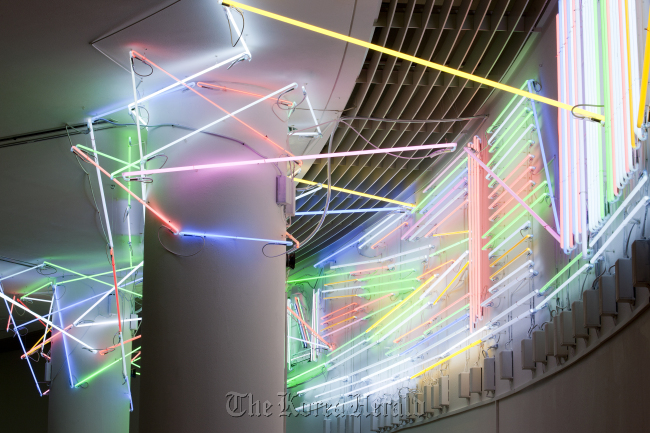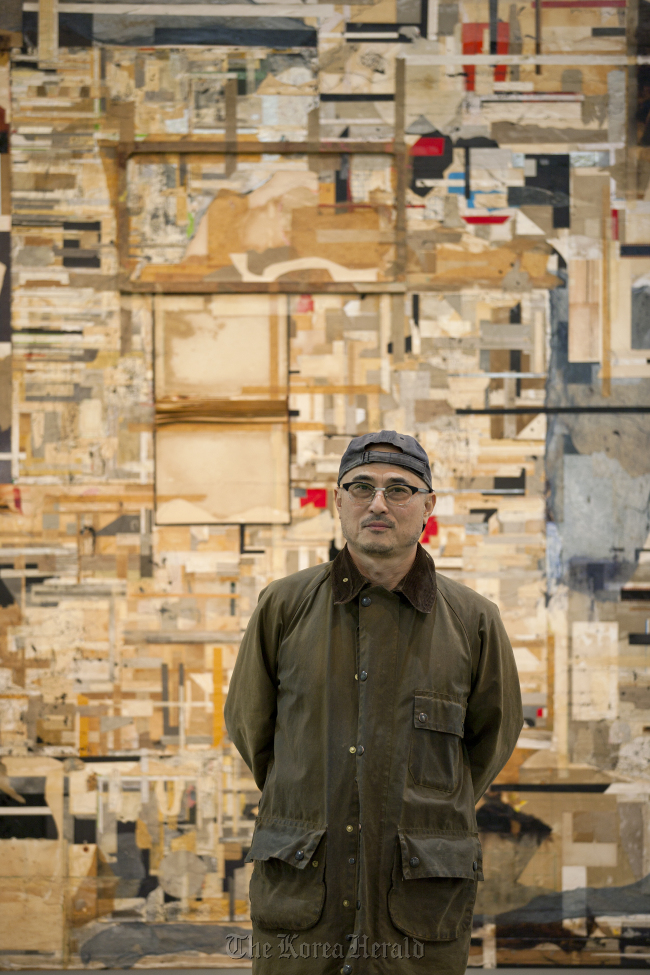Assemblage of images, time and sound
Japanese artist Shinro Ohtake’s first exhibition in Korea introduces his exploration of materials
By Lee Woo-youngPublished : Nov. 25, 2012 - 18:32

Shinro Ohtake, an internationally acclaimed Japanese artist, has been pasting printed materials, advertisements and whatever images that intrigue him into notebooks for 35 years. Filled with pages of unique collages and taking on sculptural dimensions through the density of the accumulated materials, his recent scrapbook #65 weighs 28.9 kg and has 895 pages.
The mixed-media scrapbooks ― the core element of Ohtake’s art ― became the basis of his major works introduced at Kassel Documenta 2012, the 8th Gwangju Biennale in 2010, and major galleries in Japan and other countries.
His first exhibition in Korea at Artsonje Center is a comprehensive tour de force of Ohtake’s art. About 170 works are on display that incorporate diverse materials ranging from newsprint to collected photos, magazine cutouts, scraps of wallpaper and vinyl, cotton and electrical wire, found on streets and in trash.
“The moment I pick up something, I am inspired to create an artwork. The inspiration is not about curiosity about the material, but about the time that has been staying with the materials,” Ohtake said at a press conference at Artsonje Center on Friday.
He tracks time in “Time Memory” series. He uses the envelopes from mail delivered to his home and rearranges them, somewhat like conducting a geological survey to record the compressed time.
The mixed-media scrapbooks ― the core element of Ohtake’s art ― became the basis of his major works introduced at Kassel Documenta 2012, the 8th Gwangju Biennale in 2010, and major galleries in Japan and other countries.
His first exhibition in Korea at Artsonje Center is a comprehensive tour de force of Ohtake’s art. About 170 works are on display that incorporate diverse materials ranging from newsprint to collected photos, magazine cutouts, scraps of wallpaper and vinyl, cotton and electrical wire, found on streets and in trash.
“The moment I pick up something, I am inspired to create an artwork. The inspiration is not about curiosity about the material, but about the time that has been staying with the materials,” Ohtake said at a press conference at Artsonje Center on Friday.
He tracks time in “Time Memory” series. He uses the envelopes from mail delivered to his home and rearranges them, somewhat like conducting a geological survey to record the compressed time.

“The envelopes are considered useless after the letters have been taken out, but I began to think time is also enclosed within the mail,” said Ohtake.
He also examines how we see objects through his “Retina” series, developed from his experiments with a Polaroid camera. He focuses on “how we see objects” rather than “what we see” through ball-point pen drawings on failed Polaroid photos, which are crumpled, printed and processed in various ways.
The collage works from his earlier period are on view on the second floor of the gallery.
On the third floor, the theme of collage takes new shapes, morphing into landscape paintings, drawings and light installation.
The “ZYAPANORAMA” painting series features a panorama of Japan that contrasts with traditional Japanese landscape paintings done in neutral colors. Rather than capturing beautiful scenery, the artist depicts ugly scenes of Japanese cities such as pachinko parlors, popular gambling places, love hotels.
“It can be interpreted as another form of collage ― collecting images of unattractive scenes of Japan neglected by its people,” said the curator, who added that the words written on the painting do not have anything to do with the images or contain any serious meanings.
The artist also presents a new neon installation that symbolizes Seoul. He collected disposed neon signs on the streets of Seoul and added sound captured from broken neon signs in Japan.
“Light and sound were two things that I felt most intense feelings toward while walking on the streets of Seoul. Like always, when I saw discarded neon signs on streets, I was inspired to create the neon installation,” said Ohtake.
Sound is the other material Ohtake uses for his collage works. And making music is also a form of collage for Ohtake, who is also an influential musician in Japan’s experimental music scene and a member of the music and art group “Puzzle Punks.”
“When I make music, I consider the sound as material for collage. And I always carry a recorder to record various sounds in different places I go,” said Ohtake.
The exhibition continues through Jan. 20 at Artsonje Center in Samchoeng-dong, Seoul. It is open from 11 a.m.-7 p.m. and closed on Mondays and on New Year’s Day. Admission is 5,000 won for adults and 3,000 won for students. For more information, call (02) 733-8945.
By Lee Woo-young (wylee@heraldcorp.com)




![[Music in drama] Rekindle a love that slipped through your fingers](http://res.heraldm.com/phpwas/restmb_idxmake.php?idx=644&simg=/content/image/2024/05/01/20240501050484_0.jpg&u=20240501151646)

![[New faces of Assembly] Architect behind ‘audacious initiative’ believes in denuclearized North Korea](http://res.heraldm.com/phpwas/restmb_idxmake.php?idx=644&simg=/content/image/2024/05/01/20240501050627_0.jpg&u=20240502093000)




![[KH Explains] Will alternative trading platform shake up Korean stock market?](http://res.heraldm.com/phpwas/restmb_idxmake.php?idx=644&simg=/content/image/2024/05/01/20240501050557_0.jpg&u=20240501161906)






![[Today’s K-pop] Stray Kids go gold in US with ‘Maniac’](http://res.heraldm.com/phpwas/restmb_idxmake.php?idx=642&simg=/content/image/2024/05/02/20240502050771_0.jpg&u=)